- Home
- Alex Archer
Rogue Angel 55: Beneath Still Waters Page 16
Rogue Angel 55: Beneath Still Waters Read online
Page 16
“No,” Garin interrupted. “I’ll go.”
Annja rounded on him, annoyed. “Are you suggesting that there’s something down there that I won’t be able handle?”
Garin looked at her with so little expression that Annja was sure that he was holding back laughter. That suspicion only grew when it took him several seconds to get his response out.
At last he said, “Nothing of the sort, actually. I outweigh both of you. If the ladder is going to break, it is most likely going to do so under my weight and not yours. If you go down first and the ladder breaks when I follow you, that means there will be at least two of us stuck down there. If I go down first and the ladder breaks, only one of us gets stuck, leaving the two of you to find a way to get me out.”
Annja felt her cheeks heating up at Garin’s perfectly reasonable explanation, and she did her best to ignore the sensation.
“Right. I knew that,” she said, turning away so she didn’t see the smirk trying to break free on Garin’s face.
Garin took hold of the rails on either side of the ladder and stepped down onto the second crossbar, testing to see if it would hold his weight.
When it did, he began his descent. He eased down, one crossbar at a time, until he reached the bottom, then stepped onto the interior deck of the submarine, doing his best not to step on the bones of the skeleton that were lying at his feet.
“I’m good,” he called up the others. “Send Paul down next.”
Once Paul reached the bottom, Annja started her descent, and soon the three of them were standing in the central control room taking a look around.
The first thing that Annja noticed was that the compartment was cramped. She’d expected it to be, it was a submarine after all, but it was even smaller than she expected. There was a heavy bulkhead at each end of the compartment, with a hatch in the center leading to either end of the boat. In the center were large cylindrical tubes that no doubt housed the optics for the periscope. Around them were crammed multiple work stations for the command crew. The port side held the main helm controls, the main vent controls, what looked to Annja like a bilge pump and a large tank of some kind, possibly for drinking water. On the starboard side was an exposed motor, most likely for the periscope, the compass and attack computer, and the ladder up to the conning tower.
She and her companions nearly filled the space; Annja couldn’t imagine what it would have been like with six to eight men working in here at the same time. She was very glad that she wasn’t claustrophobic, for if she had been, she doubted that she could have gone any farther.
The skeleton lying at the base of the ladder wasn’t the only one; Annja counted two more. There was also a fair amount of evidence that a fight of some kind had taken place. There were broken gauges, what looked like bullet holes in the bulkheads, and even a soot-blackened area where the navigator’s table should have stood.
She supposed a fire could have caused the damage she was seeing, but that didn’t explain the bullet holes. Had the soldiers fought among themselves and accidentally caused a fire? Had the three dead men been trapped by the flames or were they dead, possibly from the smoke, before the fire broke out?
* * *
WITHOUT A PROPER lab in which to analyze the remains, she would never know.
That made the archaeologist in her twitch in discomfort.
She bent next to the nearest skeleton and looked closely. She could see small bits and pieces of cloth between and under several of the bones and realized that it was all that was left of the man’s uniform. It looked as if he’d died in his chair, doing his duty.
Paul interrupted her thoughts.
“Why did they leave the bodies here?”
She turned and frowned at Paul, not sure if she’d heard him correctly. “What was that?”
“Why weren’t the bodies given a proper burial?” he asked. “Wasn’t that the custom back then?”
It was. Honoring the dead was one of the customs that transcended cultural and physical boundaries.
Which made Paul’s question all the more curious.
So why not now? Why not here? What had happened to the crew that was so bad that it kept them from tending to their own? she wondered.
That was the question of the day, it seemed.
“I don’t know,” she told Paul. “Maybe they were the last survivors and there was no one left to take care of them when it was their time to go.”
It was as good an explanation as any, she supposed, but it made the presence of the skeletons even more upsetting than before.
What was so deadly that it killed all three men at the same time, right where they were?
Plague was the first thought that popped into her head.
It wasn’t a very comforting one.
Paul had to have been thinking something similar because he stepped away from the skeleton he’d been examining, and said, “You know, this might not be such a good idea. Maybe we should go.”
But Annja shook her head. “We can’t leave. We don’t know what we are looking for, and this is a pretty big island to search blindly. If we’re going to meet the deadline, we need to find a clue as to where to begin looking for Hitler’s hideaway. The best place to find something like that is on this boat.”
She couldn’t help but add, “Besides, if they did have something like bubonic plague, you can rest assured that you’ve contracted it already.”
The stricken look that crossed Paul’s face in response to her comment told her it probably wasn’t as funny as she thought it was.
She considered what she knew about U-boats, trying to remember where the captain’s cabin, if it could even be called that, was on the boat.
Forward of the control room? Aft?
She couldn’t recall.
In the absence of clear direction, she mentally flipped a coin and when it came up tails, chose aft. Walking to the hatch in the bulkhead at the rear of the room, Annja examined the flywheel in the center. Unlike the wheel on the hatch above, this one was free of rust and in good shape. She dug her trusty can of bolt loosener out of the duffel hanging over her shoulder and gave the flywheel a few sprays before giving it an experimental turn.
It didn’t budge.
She peered at the flywheel, using her light and getting in close, but it looked just fine. There was no rust that she could see, nothing gumming up the works.
It should open.
Unless it was locked or jammed from the other side.
Oddly unsettled by the notion but not sure why, Annja turned and moved to the other end of the compartment. Garin was trying to open the opposite hatch, with about as much success as she’d had with hers.
This one, too, seemed to be locked or jammed from the opposite side.
“Are there any other hatches topside that we can use?” Paul asked.
Annja shook her head. “The conning tower hatch is the only real entrance to the submarine.”
“What do you mean ‘real entrance’?” Garin asked.
“I mean an entrance that the crew normally uses. That doesn’t mean that it’s the only way into the ship, just that it’s the one that sane people use. For instance, technically speaking, if you were small enough and the doors on both ends were open, I suppose you could climb through either the forward or aft torpedo tubes and get in that way, but even I’m not crazy enough to try that.”
“So we’re dead in the water?”
“I didn’t say that.” Garin’s question had gotten her thinking about the other ways into the boat and one big one stuck out in her mind.
“We could try the escape hatch.”
“What’s that?” Paul asked.
“It’s an emergency hatch built into the floor of the forward torpedo room. It was designed to allow the men in that compartment to escape the boat in the event of an emergency.”
“Did it work?”
Annja shrugged. “Not really. The difference in pressurization between the air inside the boat and the water out
side meant that the hatch couldn’t be opened until the hatch compartment was flooded. The guys trying to escape would have to climb inside, calmly wait for the chamber to flood, and then open the hatch before swimming for the surface. When your boat is headed for the ocean floor, it’s awfully hard to stay calm enough to do something like that. Never mind the fact that if you do pull it off and get the hatch open, it might already be too deep for it to make any difference and you drown on the way up.”
“And you think we can use this to get inside that part of the boat?” Garin asked.
“Possibly. If I can get the outer hatch open and if the hatch mechanism still works well enough to flood the interior chamber, then yes, we might be able to.”
She thought about it for a few seconds and then said, “Yeah, I think it’s worth a try.”
Chapter 25
Annja knew that the number of successful escapes from a sinking submarine using the hatch she’d just described were few and far between. Normally that might have given her pause, but in this instance she didn’t think it really mattered. After all, she wasn’t trying to get out of a sinking sub, she was trying to get inside one. One that was still tied to a dock, no less. That should make all the difference in the world.
Still, to be as safe as possible, they decided that Annja would wear a scuba tank during the attempt and would carry the small underwater cutting torch from the Reliant’s emergency tool kit. That way, if something went wrong with the hatch and she found herself trapped in the compartment, she would have air to breathe while she cut through the hatch in order to get free.
Having decided on their next step, the trio returned to the Reliant to gather the necessary tools. The lagoon water was warm—a pleasant change from the icy Alpine lake that was the site of her last dive—and so there was no need for special equipment like a dry suit and its associated layers of clothing. For this dive, all Annja would need was her wet suit, her scuba gear, her light and a small cutting torch.
By late morning they were back in the dinghy and motoring to the submarine for the second time that day. Instead of tying off at the dock on the other side from the boat, however, this time Garin brought them in close, right up next to the bow of the warship. He shut down the outboard motor and had Paul drop the anchor over the side to keep them from drifting.
Annja checked her tank and regulator, then pulled on her mask and flippers. She sat on the edge of the boat with her back to the water and, with a thumbs-up to Garin, fell over backward into the lagoon.
The water was clear and visibility was good. She swam over to the hull of the submarine and followed it forward until she reached the mouths of the forward torpedo tubes. Using that as her reference point, she dived deeper, under the keel, then began shining her light across the hull, looking for the hatch leading into the escape trunk.
It didn’t take her long; the hatch was partially open, which made it fairly easy to see along the smooth curve of the hull. She swam over to it and shone her light through the hatch into the compartment, checking to be sure some denizen of the deep hadn’t decided to take up residence there. The space was empty, so she wouldn’t have to chase out a moray eel or any barracuda. The interior hatch leading from the escape trunk into the ship proper seemed to be closed, which was a good sign that the forward compartment she hoped to enter was still airtight.
She spent several minutes clearing as much of the growth from the hinges as she could, and pushed the hatch back and forth to be certain it would move. It was a bit stiff at first, but after several repetitions it seemed to move a little easier.
Annja grabbed hold of the hatch’s inner handle and slipped into the escape trunk. She pulled the hatch shut behind her as she did so and shoved the lever that pulled the hatch closed.
The escape trunk had been designed to hold four seated men at the same time. Annja had plenty of room around her but had to remain in a crouch or she’d bang her head against the hatch above her.
Now came the real test.
After spending so many decades moored in the same spot, Annja knew the charge on the submarine’s batteries had long since failed, so she didn’t bother trying the controls to power the drain. Instead she shone her light against the inner chamber wall to the left of the control panel until she found the hand crank that served as the backup control system. She had to hit it with her dive light several times before it would move, but at last she got it to turn. She spun the crank clockwise as far as it would go and then locked it into place.
She waited.
After a few seconds Annja felt the water begin to flow down her body, draining out of the escape trunk as the bladder she’d just activated forced air into the trunk, increasing the pressure and pushing the water out through the drains beneath her feet.
When the water had drained completely, Annja removed her regulator and tested the air.
The wave of dizziness that washed over her in the seconds before she got her regulator back into her mouth and took a gulp of clean oxygen told her that the air inside the trunk was anything but breathable.
That’s fine, she thought. I’ll just stay on the regulator while I check things out.
Now that the air pressure inside the trunk matched the air pressure inside the submarine, she should be able to open the inner hatch without flooding the entire ship in the process.
She crossed her fingers, made a quick plea to whoever might be listening, and then reached up and grabbed the flywheel in the center of the hatch above her head.
Unlike the others she’d encountered so far, this one spun easily. She gave it a few hard cranks and then, when the wheel wouldn’t move any farther, pushed upward on the hatch.
It fell open with a bang.
She was in!
Annja stood up and, in doing so, brought her head and shoulders out of the escape trunk and into the forward torpedo room. She was relieved to see that the compartment had remained watertight even after all this time. There was air in the chamber as well, but she knew that it would more than likely be stagnant, too. Until they could open the inner hatch and allow some fresh air to flow down the conning tower hatch and into the rest of the boat, she was going to have to keep breathing from her tank.
Putting her hands on the floor next to the hatch, she boosted herself out of the escape trunk and into the torpedo room. She left the hatch open behind her, wanting to be sure she had at least one avenue of escape if she couldn’t get the interior hatch leading to the control room open from this side. Worrying about the outer hatch was bad enough; she didn’t want to be concerned that the inner one wouldn’t open.
Annja looked around.
To the rear of the compartment were three sets of bunk beds, which she guessed had to have been the accommodations for the junior ratings aboard. Next to those and closer to her was the torpedo loading rack, which held two torpedoes. The angled loading hatches for the four aft-facing torpedo tubes were next, while overhead hung a hoist used to maneuver the torpedoes from their storage space below the decking up onto the rack. There was a bulkhead hatch blocking off this compartment from the next. When she tried the flywheel, it spun without resistance and she was able to move aft, toward the control room where the others were waiting.
Passing through that first bulkhead, the next compartment in line was another wardroom of sorts, with two sets of bunks on either side of the aisle. As she flashed her light across the beds, she saw that she was no longer alone.
Three of the four bunks were occupied.
She started, surprised, her breath echoing in her ears through the regulator, but then she relaxed when she got a closer look at the beds’ occupants. As with the sailors in the control room, these men weren’t going anywhere. They were little more than skeletons in gray uniforms, the flesh having long since decayed, but the clothing they wore was far better preserved than that worn by their companions in the control room.
Annja noticed something sticking up from the body in one of the lower bunks. She reached out and car
efully pulled it from the rib cage that had kept it in place for so many years.
It was an arrow with a wooden shaft and fletching made from the dark feathers of some kind of tropical bird. The broken remains of a bone tip were still tied to the other end. The rest was probably still stuck somewhere in the man’s skeleton.
Despite her earlier thoughts about plague, she realized that the answer was much simpler. These men hadn’t died of some mysterious illness at all, but rather at the hands of men just like themselves. She didn’t know what they’d done to deserve death, if they’d done anything at all, but somehow the crew had made some deadly enemies upon arrival and had paid the ultimate price for those transgressions.
There was a mystery to be solved here, more than one, actually, but now was not the time. Annja pressed on, knowing the others were waiting for her.
The next bulkhead led to another wardroom, this one with bunks on the right and a small table on the left. There was a little more space in this compartment than in the previous one, but not much.
Officers’ quarters, she thought.
Annja knew she was closing in on the middle of the boat, and a check of her air supply showed that she still had about half a tank left. If things continued at the pace they were going, she would have plenty.
Beyond the wardroom, she found the radio and sound detection rooms on the right and a single bunk with a curtain in front of it on the left.
That curtain—and the fact that the bunk was opposite the two most important stations on the boat—told her that it was the captain’s bunk. The location allowed him to be kept abreast of new orders or new contacts as soon as they came in while the curtain served as the only bit of privacy that the man had. It wasn’t much, but on a boat of this size it probably felt like heaven to be able to close yourself off, even for just a few minutes, from everyone else.
This was the first place that she intended to search for an answer to what had happened to the boat and its crew, but first she had to open the bulkhead hatch and let her companions, as well as some fresh air, into the boat.

 Rogue Angel: Forbidden City
Rogue Angel: Forbidden City The Spider Stone
The Spider Stone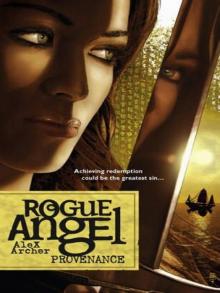 Provenance
Provenance Blood Cursed
Blood Cursed Fury's Goddess
Fury's Goddess The Spirit Banner
The Spirit Banner Footprints
Footprints The Pretender's Gambit
The Pretender's Gambit Rogue Angel: The Lost Scrolls
Rogue Angel: The Lost Scrolls Staff of Judea
Staff of Judea Rogue Angel 55: Beneath Still Waters
Rogue Angel 55: Beneath Still Waters The Mortality Principle
The Mortality Principle Warrior Spirit
Warrior Spirit Paradox
Paradox Tear of the Gods
Tear of the Gods Forbidden City
Forbidden City River of Nightmares (Rogue Angel)
River of Nightmares (Rogue Angel) Rogue Angel: The Secret of the Slaves
Rogue Angel: The Secret of the Slaves Destiny
Destiny Rogue Angel 51: The Pretender's Gambit
Rogue Angel 51: The Pretender's Gambit Celtic Fire
Celtic Fire Rogue Angel 54: Day of Atonement
Rogue Angel 54: Day of Atonement Day of Atonement
Day of Atonement Rogue Angel: Gabriel's Horn
Rogue Angel: Gabriel's Horn Grendel's Curse
Grendel's Curse The Matador's Crown
The Matador's Crown Rogue Angel: The Chosen
Rogue Angel: The Chosen The Other Crowd
The Other Crowd Seeker’s Curse
Seeker’s Curse Rogue Angel 52: Death Mask
Rogue Angel 52: Death Mask The Golden Elephant
The Golden Elephant Blood Cursed (Rogue Angel)
Blood Cursed (Rogue Angel) Celtic Fire (Rogue Angel)
Celtic Fire (Rogue Angel) Gabriel's Horn
Gabriel's Horn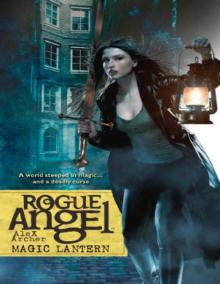 Magic Lantern (Rogue Angel)
Magic Lantern (Rogue Angel) God of Thunder
God of Thunder Clockwork Doomsday
Clockwork Doomsday The Bone Conjurer
The Bone Conjurer Treasure of Lima
Treasure of Lima The Soul Stealer
The Soul Stealer The Dragon’s Mark
The Dragon’s Mark Restless Soul
Restless Soul Rogue Angel: God Of Thunder
Rogue Angel: God Of Thunder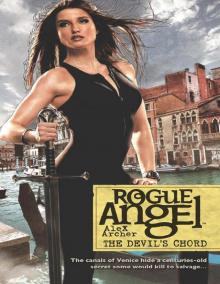 Rogue Angel 49: The Devil's Chord
Rogue Angel 49: The Devil's Chord Death Mask
Death Mask Rogue Angel 46: Treasure of Lima
Rogue Angel 46: Treasure of Lima Swordsman's Legacy
Swordsman's Legacy The Oracle's Message
The Oracle's Message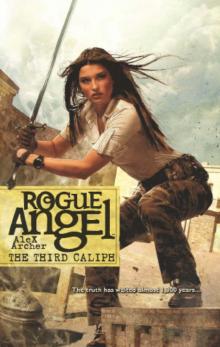 The Third Caliph
The Third Caliph Tribal Ways
Tribal Ways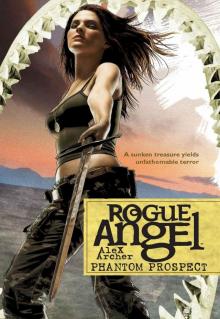 Phantom Prospect
Phantom Prospect Rogue Angel 50: Celtic Fire
Rogue Angel 50: Celtic Fire Library of Gold
Library of Gold Rogue Angel 53: Bathed in Blood
Rogue Angel 53: Bathed in Blood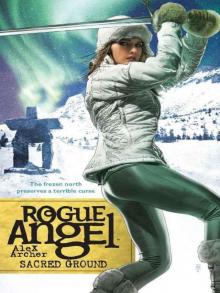 Sacred Ground
Sacred Ground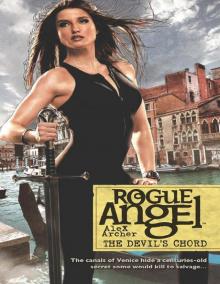 The Devil's Chord
The Devil's Chord Serpent's Kiss
Serpent's Kiss The Vanishing Tribe
The Vanishing Tribe Sunken Pyramid
Sunken Pyramid Sunken Pyramid (Rogue Angel)
Sunken Pyramid (Rogue Angel) City of Swords
City of Swords Bathed in Blood
Bathed in Blood The Lost Scrolls
The Lost Scrolls The Babel Codex
The Babel Codex Mystic Warrior
Mystic Warrior Eternal Journey
Eternal Journey Beneath Still Waters
Beneath Still Waters Solomon's Jar
Solomon's Jar Beneath Still Waters (Rogue Angel Book 55)
Beneath Still Waters (Rogue Angel Book 55) Cradle of Solitude
Cradle of Solitude Secret of the Slaves
Secret of the Slaves River of Nightmares
River of Nightmares Polar Quest
Polar Quest False Horizon
False Horizon